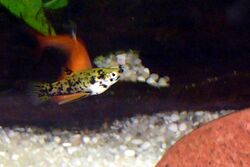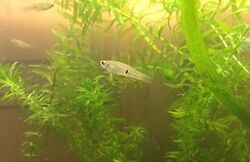Biology:Dusky millions fish
| Dusky millions fish | |
|---|---|

| |
| Scientific classification | |
| Domain: | Eukaryota |
| Kingdom: | Animalia |
| Phylum: | Chordata |
| Class: | Actinopterygii |
| Order: | Cyprinodontiformes |
| Family: | Poeciliidae |
| Genus: | Phalloceros |
| Species: | P. caudimaculatus
|
| Binomial name | |
| Phalloceros caudimaculatus (R. F. Hensel, 1868)
| |
| Synonyms[1] | |
|
Girardinus caudimaculatus Hensel, 1868 | |
The dusky millions fish, speckled mosquitofish or the one-spot livebearer (Phalloceros caudimaculatus) is a species of fish native eastern and southern Brazil , northern Argentina , Uruguay and Paraguay.[1] It has also been introduced to Australia , Malawi and New Zealand; primarily for mosquito control, but also as escapees from the aquarium trade.[1] It has been reported as having adverse ecological effects in areas where it has been introduced.[1] The females of this species grow to a total length of 6 centimetres (2.4 in), while males remain smaller.[1]
Origins
This species originated in South America.[2] It is mainly a freshwater fish and thrives best in areas with weak water flow.[2] However, it is extremely adaptable and can thrive in a multitude of altered environments.[2] For example, although it prefers temperatures between 16 and 22 °C (61–72 °F), it can survive up to 30 °C (86 °F)[3] and down to 5 °C (41 °F).[2] The species also has a high fecundity.[4]
The dusky millions fish was one of the first species in its family, the Poeciliidae to be bred for aquarium usage.[2] Ecologists also attempted to use the fish as a mosquito control; however, the mosquito fish's diverse diet affected its efficacy as a control species.[2] The mosquito fish can eat a range of different organisms, including algae.[2]

Role as an invasive species
The dusky millions fish was introduced to a variety of ecosystems both by aquarium keepers and as mosquito pest control.[2] The NSW area of Australia has been affected the most by its presence.[2] It reproduces and spreads well in the winter when there is a larger flow of water.[2] Australian ecologists have tried to contain this spread by killing them with rotenone; however, the infestation persists.[2] This species is most likely to be found in shallow areas with varying levels of vegetation, such as local ponds.[4]
The ecological impact of the dusky millions fish in Australia is pronounced. Its diet has affected populations of both native and non-native fish.[4] An example would be the non-native species Gambusia holbrooki.[4] It has similar features as the dusky millions fish, such as a high reproductive rate and use for mosquito control.[4] However, its population in Australia has diminished since the introduction of the dusky millions fish.[4] Furthermore, this dusky millions fish has also affected the food chain, as they have become prey for native bird species.[4]
References
- ↑ Jump up to: 1.0 1.1 1.2 1.3 1.4 Froese, R; Pauly, D, eds. "Phalloceros caudimaculatus summary page". http://www.fishbase.org/summary/Phalloceros-caudimaculatus.html.
- ↑ Jump up to: 2.00 2.01 2.02 2.03 2.04 2.05 2.06 2.07 2.08 2.09 2.10 Maddern, M.G. (2008). "Distribution and spread of the introduced One-spot Livebearer Phalloceros caudimaculatus (Pisces: Poeciliidae) in southwestern Australia". Journal of the Royal Society of Western Australia (91): 229–235. http://www.rswa.org.au/publications/Journal/91(3)/roy%20soc%20vol%2091%20pt%203%20maddern%20lo-res.pdf. Retrieved November 23, 2015.
- ↑ SeriouslyFish: Phalloceros caudimaculatus. Retrieved 21 March 2017.
- ↑ Jump up to: 4.0 4.1 4.2 4.3 4.4 4.5 4.6 Rowley, J. J. L.; Rayner, T. S.; Pyke, G. H. (2005-09-01). "New records and invasive potential of the poeciliid fish Phalloceros caudimaculatus". New Zealand Journal of Marine and Freshwater Research 39 (5): 1013–1022. doi:10.1080/00288330.2005.9517372. ISSN 0028-8330.
Wikidata ☰ Q964662 entry
 |

